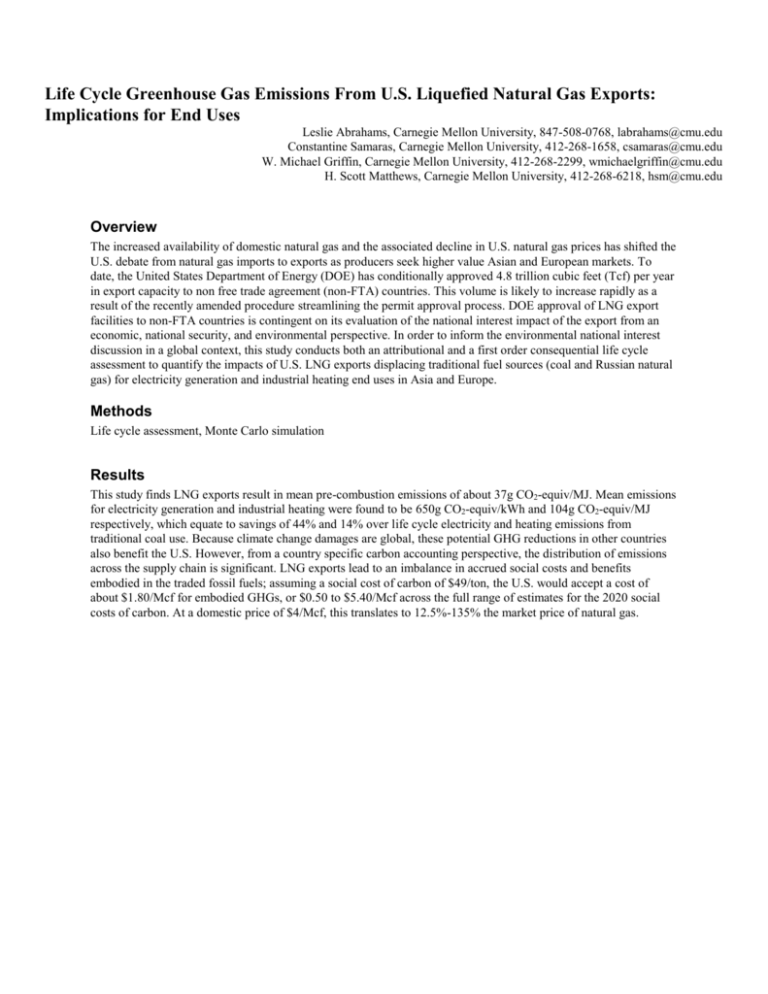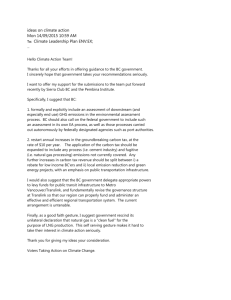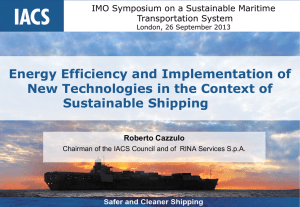View Extended Abstract - United States Association for Energy
advertisement

Life Cycle Greenhouse Gas Emissions From U.S. Liquefied Natural Gas Exports: Implications for End Uses Leslie Abrahams, Carnegie Mellon University, 847-508-0768, labrahams@cmu.edu Constantine Samaras, Carnegie Mellon University, 412-268-1658, csamaras@cmu.edu W. Michael Griffin, Carnegie Mellon University, 412-268-2299, wmichaelgriffin@cmu.edu H. Scott Matthews, Carnegie Mellon University, 412-268-6218, hsm@cmu.edu Overview The increased availability of domestic natural gas and the associated decline in U.S. natural gas prices has shifted the U.S. debate from natural gas imports to exports as producers seek higher value Asian and European markets. To date, the United States Department of Energy (DOE) has conditionally approved 4.8 trillion cubic feet (Tcf) per year in export capacity to non free trade agreement (non-FTA) countries. This volume is likely to increase rapidly as a result of the recently amended procedure streamlining the permit approval process. DOE approval of LNG export facilities to non-FTA countries is contingent on its evaluation of the national interest impact of the export from an economic, national security, and environmental perspective. In order to inform the environmental national interest discussion in a global context, this study conducts both an attributional and a first order consequential life cycle assessment to quantify the impacts of U.S. LNG exports displacing traditional fuel sources (coal and Russian natural gas) for electricity generation and industrial heating end uses in Asia and Europe. Methods Life cycle assessment, Monte Carlo simulation Results This study finds LNG exports result in mean pre-combustion emissions of about 37g CO2-equiv/MJ. Mean emissions for electricity generation and industrial heating were found to be 650g CO2-equiv/kWh and 104g CO2-equiv/MJ respectively, which equate to savings of 44% and 14% over life cycle electricity and heating emissions from traditional coal use. Because climate change damages are global, these potential GHG reductions in other countries also benefit the U.S. However, from a country specific carbon accounting perspective, the distribution of emissions across the supply chain is significant. LNG exports lead to an imbalance in accrued social costs and benefits embodied in the traded fossil fuels; assuming a social cost of carbon of $49/ton, the U.S. would accept a cost of about $1.80/Mcf for embodied GHGs, or $0.50 to $5.40/Mcf across the full range of estimates for the 2020 social costs of carbon. At a domestic price of $4/Mcf, this translates to 12.5%-135% the market price of natural gas. Conclusions The complex interaction between environmental, social, and economic consequences of U.S. LNG exports makes predicting net GHG impacts complicated. This study provides a bounding analysis of potential GHG impacts of exporting LNG in order to advise policymakers on the non-intuitive potential outcomes of expanded export capacity. The most likely outcome across all scenarios is that U.S. LNG can reduce global greenhouse gas emissions when displacing Russian natural gas or coal combustion for electricity and industrial heating. However, there is an opportunity cost of exports due to the fact that the life cycle stages of liquefying, shipping, and regasifying the natural gas result in an 11% increase of GHG emissions over domestic combustion. Additionally, from this work we find U.S. LNG exports result in an imbalance of accrued social costs and benefits from a country-specific carbon accounting perspective. This is an important consideration because increased international fossil fuel trade has prompted the discussion for new climate policies that recognize the responsibility of embodied carbon contributions at all points in the supply chain of goods and services, including mechanisms to penalize carbon emissions at the point of fossil fuel extraction. Such emissions inventories for global climate discussions traditionally focus on what is emitted within a country’s borders, rather than on the net global consequential impact of those emissions. Therefore, while U.S. LNG exports have the potential to reduce global net GHG emissions from a life cycle emissions perspective, economic benefits of natural gas development explicitly for export purposes needs to be analyzed against the monetized domestic social costs. These include environmental and public health risks, and potentially the expected increase in costs for domestic emissions reductions. This social cost differential may be important to consider as a component of the national interest determination.











